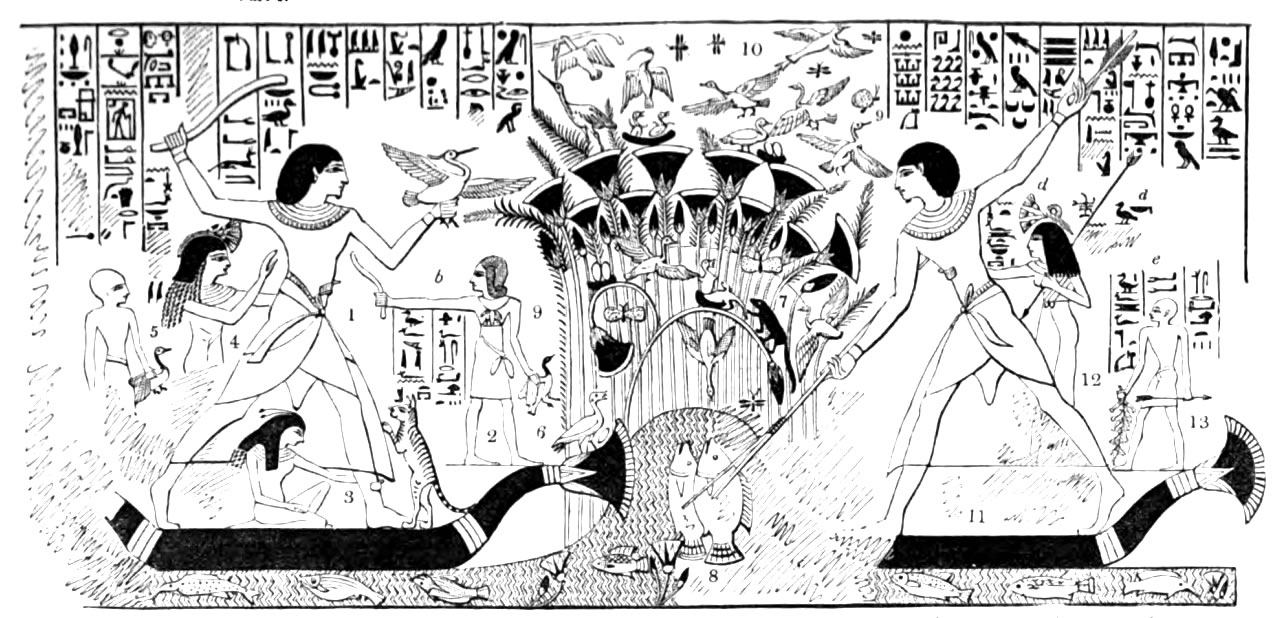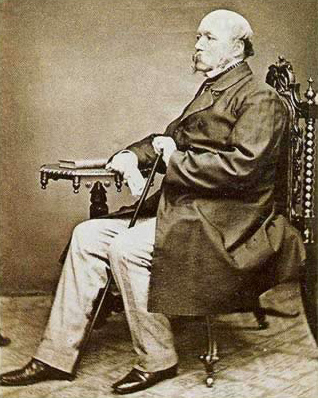|
Tomb A.24
Tomb A.24 is the modern number given to a now lost Theban tomb in Dra' Abu el-Naga'. The burial dates to the ancient Egyptian 18th Dynasty and belongs to the ''second priest of Amun'' Simut. The tomb was already known in the early 19th century and was visited by several early travelers, such as Jean-François Champollion and John Gardner Wilkinson. Especially the latter made several copies of the painted decoration. He seems to have seen the tomb in a fairly good state of preservation while it was already more destroyed when Jean-François Champollion came later. He copied some inscriptions. Several scenes can be reconstructed from these early accounts. There was a depiction showing the family of Simut receiving offerings, most likely in connection with a festival, called the Valley festival. The second scene shows the family of Simut hunting in the marshes. The scene was drawn by John Gardner Wilkinson and later published by him. A third scene must have shown vintage. Wilkinson ... [...More Info...] [...Related Items...] OR: [Wikipedia] [Google] [Baidu] |
Dra' Abu El-Naga'
The necropolis of Draʻ Abu el-Naga' ( ar, دراع ابو النجا) is located on the West Bank of the Nile at Thebes, Egypt, just by the entrance of the dry bay that leads up to Deir el-Bahari and north of the necropolis of el-Assasif. The necropolis is located near the Valley of the Kings. History According to the German Institute of Archeology or DAI, "Dra' Abu el-Naga is one of the longest occupied necropolis of Ancient Egypt: it was used as a burial place almost continuously between the Middle Kingdom and the early Christian (Coptic) periods, i.e. a period of ca. 2500 years. The oldest graves documented so far date to the end of the 11th dynasty (ca. 2000 B.C.). During the Seventeenth Dynasty and early 18th dynasty, kings and their wives were interred here. The social spectrum of the private necropolis ranges from simple burials with few grave goods to the burials of higher-ranking individuals e.g. the High Priests of Amun of Karnak and other high officials. In the early M ... [...More Info...] [...Related Items...] OR: [Wikipedia] [Google] [Baidu] |
Tomb A
A tomb ( grc-gre, τύμβος ''tumbos'') is a repository for the remains of the dead. It is generally any structurally enclosed interment space or burial chamber, of varying sizes. Placing a corpse into a tomb can be called ''immurement'', and is a method of final disposition, as an alternative to cremation or burial. Overview The word is used in a broad sense to encompass a number of such types of places of interment or, occasionally, burial, including: * Architectural shrines – in Christianity, an architectural shrine above a saint's first place of burial, as opposed to a similar shrine on which stands a reliquary or feretory into which the saint's remains have been transferred * Burial vault – a stone or brick-lined underground space for multiple burials, originally vaulted, often privately owned for specific family groups; usually beneath a religious building such as a church ** Cemetery ** Churchyard * Catacombs * Chamber tomb * Charnel house * Church monum ... [...More Info...] [...Related Items...] OR: [Wikipedia] [Google] [Baidu] |
Simut
Simut or Samut (“Son of Mut”) was an ancient Egyptian priest who held the position of Second Prophet of Amun towards the end of the reign of Pharaoh Amenhotep III. He is known from a number of objects, including his (now lost), Theban tomb chapel Tomb A.24. He started his career as a ''wab'' priest in the temple of Amun and a porter of the god's processional shrine. In the 20th regnal year of Amenhotep he was already the Fourth Prophet of Amun, which means he was the fourth highest ranking priest in the most influential priesthood of the era. He was appointed Second Prophet in Year 34, it is likely that the previous holder of the title, Anen Anen or Aanen was an ancient Egyptian official during the late 18th Dynasty of Egypt. Biography He was the son of Yuya and Thuya and the brother of Queen Tiye, the wife of Pharaoh Amenhotep III. Under the rule of his brother-in-law, Anen beca ..., the pharaoh's brother-in-law died around this time. Simut was also treasurer (“Overse ... [...More Info...] [...Related Items...] OR: [Wikipedia] [Google] [Baidu] |
Bertha Porter
Bertha Porter (1852-1941) was an English biographer and bibliographer known for her editorial role in the compilation of the ''Topographical Bibliography of Ancient Egyptian Hieroglyphic Texts, Reliefs, and Paintings''. Early life Bertha Porter was born in 1852 to Frederick William Porter, an architect of Irish birth and from 1860 surveyor to the Worshipful Company of Clothworkers, and his wife Sarah Moyle; little is known of Bertha's life, other than that she moved in literary circles. Her parents owned property in London and Hythe. Writing Porter was engaged by Sidney Lee to write for the Dictionary of National Biography, completing 156 biographies by the time she left. Francis Llewellyn Griffith, whilst working at the British Museum (he left in 1896), established funding and direction for the compilation of a ''Topographical Bibliography of Ancient Egyptian Hieroglyphic Texts, Reliefs, and Paintings'', with the purpose of establishing the location and content of texts found on ... [...More Info...] [...Related Items...] OR: [Wikipedia] [Google] [Baidu] |
Rosalind Moss
Rosalind Louisa Beaufort Moss, FSA (21 September 1890 – 22 April 1990) was a British Egyptologist and bibliographer, noted for her work on ''The Topographical Bibliography of Ancient Egyptian Hieroglyphic Texts, Reliefs and Paintings''. Biography Rosalind was born at Shrewsbury School, Shropshire, England. She was educated at Heathfield School, Ascot and read for a diploma in anthropology as a student in the Society of Oxford Home Students, which later became St Anne's College. She participated in archaeological excavations at the palaeolithic site of La Cotte de St Brelade in Jersey in 1914, directed by her tutor Robert Ranulph Marett. Rosalind was awarded the diploma in anthropology in 1917 and a BSc in 1922 for her thesis which was published in 1925 as ''The Life after Death in Oceania and the Malay Archipelago''. Rosalind began to study Egyptology in 1917 by attending classes given by Professor Francis Griffith, who was supervising the compilation of the ''Topographical ... [...More Info...] [...Related Items...] OR: [Wikipedia] [Google] [Baidu] |
Griffith Institute
The Griffith Institute is an Egyptological institution based in the Griffith Wing of the Sackler Library and is part of the Faculty of Oriental Studies, University of Oxford, England. It was founded for the advancement of Egyptology and Ancient Near Eastern Studies by the first Professor of Egyptology at the University of Oxford, Francis Llewellyn Griffith. Griffith bequeathed funds in his will (augmented by the personal fortune of his wife Nora Griffith) for the foundation of the Institute and it opened on 21 January 1939, with its own independent committee of management. Rosalind Moss operated the Griffith Institute from its opening until the mid 1960s. The Griffith Institute Archive is home to an important and unique set of Egyptology resources. Built upon Griffith's original collection of manuscripts and excavation records, it contains and preserves early copies of inscriptions, drawings, watercolours, old negatives, photographs, squeezes, and rubbings. Among some seventy major ... [...More Info...] [...Related Items...] OR: [Wikipedia] [Google] [Baidu] |
Ashmolean Museum
The Ashmolean Museum of Art and Archaeology () on Beaumont Street, Oxford, England, is Britain's first public museum. Its first building was erected in 1678–1683 to house the cabinet of curiosities that Elias Ashmole gave to the University of Oxford in 1677. It is also the world's second university museum, after the establishment of the Kunstmuseum Basel in 1661 by the University of Basel. The present building was built between 1841 and 1845. The museum reopened in 2009 after a major redevelopment, and in November 2011, new galleries focusing on Egypt and Nubia were unveiled. In May 2016, the museum also opened redisplayed galleries of 19th-century art. History Broad Street The museum opened on 24 May 1683, with naturalist Robert Plot as the first keeper. The building on Broad Street (later known as the Old Ashmolean) is sometimes attributed to Sir Christopher Wren or Thomas Wood. Elias Ashmole had acquired the collection from the gardeners, travellers, and collectors Joh ... [...More Info...] [...Related Items...] OR: [Wikipedia] [Google] [Baidu] |
Jean-François Champollion
Jean-François Champollion (), also known as Champollion ''le jeune'' ('the Younger'; 23 December 17904 March 1832), was a French philologist and orientalist, known primarily as the decipherer of Egyptian hieroglyphs and a founding figure in the field of Egyptology. Partially raised by his brother, the scholar Jacques Joseph Champollion-Figeac, Champollion was a child prodigy in philology, giving his first public paper on the decipherment of Demotic in his mid-teens. As a young man he was renowned in scientific circles, and spoke Coptic, Ancient Greek, Latin, Hebrew and Arabic. During the early 19th century, French culture experienced a period of 'Egyptomania', brought on by Napoleon's discoveries in Egypt during his campaign there (1798–1801) which also brought to light the trilingual Rosetta Stone. Scholars debated the age of Egyptian civilization and the function and nature of hieroglyphic script, which language if any it recorded, and the degree to which the signs were p ... [...More Info...] [...Related Items...] OR: [Wikipedia] [Google] [Baidu] |
John Gardner Wilkinson
Sir John Gardner Wilkinson (5 October 1797 – 29 October 1875) was an English traveller, writer and pioneer Egyptologist of the 19th century. He is often referred to as "the Father of British Egyptology". Childhood and education Wilkinson was born in Little Missenden, Buckinghamshire. His father was a Westmoreland clergyman, the Reverend John Wilkinson, an amateur enthusiast for antiquities. Wilkinson inherited a modest income from his early-deceased parents. Sent by his guardian to Harrow School in 1813, he later went up to Exeter College, Oxford in 1816. Wilkinson ultimately took no degree and, suffering from ill-health, decided to travel to Italy. There in 1819 he met the antiquarian Sir William Gell and resolved to study Egyptology. First sojourn in Egypt Wilkinson first arrived in Egypt in October 1821 as a young man of 24 years, remaining in the country for a further 12 years continuously. During his stay, Wilkinson visited virtually every known ancient Egyptian s ... [...More Info...] [...Related Items...] OR: [Wikipedia] [Google] [Baidu] |
Samuel Birch (Ägyptologe)
Samuel Birch may refer to: * Samuel Birch (Egyptologist) (1813–1885), British Egyptologist and antiquary *Lamorna Birch Samuel John "Lamorna" Birch, RA, RWS (7 June 1869 – 7 January 1955) was an English artist in oils and watercolours. At the suggestion of fellow artist Stanhope Forbes, Birch adopted the ''soubriquet'' "Lamorna" to distinguish himself from ... (Samuel John Birch, 1869–1955), English artist * Samuel Birch (athlete) (born 1963), Liberian Olympic sprinter * Samuel Birch (Lord Mayor of London) (1757–1840), Lord Mayor of London * Samuel Birch (British Army officer) (1735–1811), compiler of the ''Book of Negroes'' and namesake of Birchtown, Nova Scotia {{hndis, Birch, Samuel ... [...More Info...] [...Related Items...] OR: [Wikipedia] [Google] [Baidu] |





